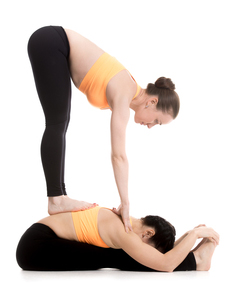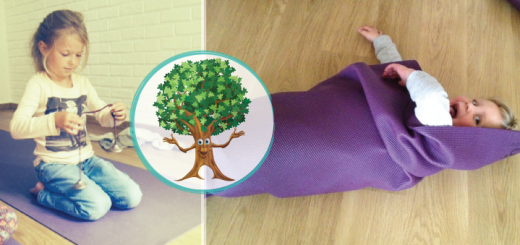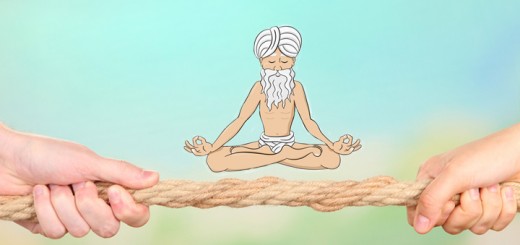Why I hate partner yoga
34I rarely blog about anything controversial. I try to keep my writing and teaching as inclusive as possible, and spouting off my unsolicited opinion doesn’t help anyone. Today, however, I’m going to ignore my own policy. Please bear with me and feel free to chastise me in the comments. ![]()
A couple of months ago, I shared an article with my teacher training students about yoga adjustments. I don’t need to write about that topic, because I agree one hundred percent with everything the Sequence Wiz folks said. So if you want to know what I think about adjustments, please read that article.
Shortly after I sent it out, however, a student asked me what I thought about partner yoga. Against my better judgment, I’m answering her publicly.
I hate it.
Hate is a strong word, but in this case, it fits. My first yoga teacher (who I adored) included partner yoga at the end of every class. I’ve tried to block the experience out of my memory, but whenever I hear the phrase, I still feel a stabbing, ice-pick-sharp pain in my groin and remember people twice my size pressing down on my knees in Baddha Konasana while exerting significantly more force than my forever-injured hips could withstand. Lest you think this was done by a teacher with more enthusiasm than training, please understand that the teacher was well regarded, very experienced, and the co-author of a book on Iyengar yoga.
The pièce de résistance of my partner yoga experience, however, occurred during one of the many end-of-class “partner yoga massages.” As usual, I hid at the back of the room, trying not to make eye contact, hoping that I’d be the odd person without a partner and could graciously sit out the experience. No such luck. While everyone else got and received shoulder rubs, my randomly-assigned “partner” asked me to rub her gluteal muscles. For those of you not anatomy inclined, let’s just call them her butt muscles. To make matters worse, she groaned in pleasure the whole time I rubbed.
When I got home and shared the embarrassing experience with my husband, he asked a reasonable question: “If you didn’t want to do it, why didn’t you say no?”
I didn’t say no for the same reason your students won’t say no the next time you ask them to do something unwise. No one else said anything, I was intimidated, I liked the teacher, and I didn’t want to make a fuss.
I eventually stopped studying with that teacher—not specifically because of the partner aspects of her classes, but because her classes kept injuring my body. Partner yoga had no small part in my injuries.
Holding hands in tree pose, balancing on top of your classmates, and stretching with arms and legs intertwined may be entertaining. It’s often beautiful. It may even falsely deepen the sensation of stretching. In the case of true partners, it can beautifully deepen emotional connection.
But asana performed for any of these reasons isn’t yoga. Not in the true sense of the word. Yoga, according to the Yoga Sutras of Patanjali, is the practice of stilling the mind. The poses we do with our bodies should be in service of that goal. Believe me, when I’m thumbs-deep in the butt muscles of a groaning stranger, my mind is anything but still.
For the record, I do think partner asana classes may have some uses, though I don’t want to teach them. Partner asana classes can help build relationships, increase trust, prepare for artistic performances, even provide tools to support a woman in labor.
But let’s be honest and call it what it is. Partner-assisted stretching, acrobatics, performance art—even call it partner asana, if you want. But don’t kid yourself. It’s not yoga. And whatever you call it, I highly doubt that for most students the benefits outweigh the risks.
Republished with permission from Tracy’s Whole Life blog
 Tracy Weber is the author of the award-winning Downward Dog Mysteries series featuring yoga teacher Kate and her feisty German shepherd, Bella. Tracy loves sharing her passion for yoga and animals in any form possible.
Tracy Weber is the author of the award-winning Downward Dog Mysteries series featuring yoga teacher Kate and her feisty German shepherd, Bella. Tracy loves sharing her passion for yoga and animals in any form possible.
Tracy and her husband live in Seattle with their challenging yet amazing German shepherd Tasha. When she’s not writing, Tracy spends her time teaching yoga, walking Tasha, and sipping Blackthorn cider at her favorite ale house.
Visit her at TracyWeberAuthor.com and https://www.facebook.com/tracywe, and check out the first two books in her series. Murder Strikes a Pose and A Killer Retreat are available at bookstores everywhere!





















I think those of us who like to use partner work in our classes need to hear the negative feedback as well as positive. We need to remember to give people a comfortable way out of participating, and to limit the activities – the average student is not ready to give assists that deepen another students’ pose, for instance.
I also think it might have been a terrific growth experience for you to find your voice to say no to rubbing your partners’ glutes. “I’m sorry, but I’m barely comfortable with touching a strangers’ shoulders, I don’t think I’m ready to rub your butt. Would you like to ask the instructor for a different partner, or should we just do the assignment?” would have been fine, I’m sure.
*note: I say the above KNOWING that I, too, would have grimaced and rubbed that butt. Learning to say no would be awesome!
Lauren, Thanks so much for commenting and you’re absolutely right. Saying no would have been the stronger (and likely healthier) option for me in that moment. But in all fairness to the woman asking for the butt rub, the assignment was to give each other massages. Which body part should be massaged wasn’t specified. I know I was the only one tasked with rubbing a butt, but others may have gotten low back massage, for example.
Agree. I was talking to a good friend about touching / hugging students. I said, I usually don’t touch students, I respect their space. If I get a hug from a student, then I give back. But my friend keeps telling me, nooo, you have to touch people, a lot. I know (and I fell) not everybody wants to be touched. And, its the same in partner yoga. Sometimes, for specifit people, I use this asanas, but only If I see and fell students are having fun. On the other side, I really don’t like “circus” yoga. I believe we have another time and space for that. Thanks for sharing your ideas. Makes me feel good that I’m not alone out there. =)
Thank you, Sonia. Touch is definitely tricky and not welcomed by all students. I remember vividly a class I taught once. A student came up to me after class and said that I touched her hand. (I didn’t remember doing so, but I’m sure she was correct.) She told me that she was on the autism spectrum and that touch was so distressing to her that she couldn’t come back to my class unless I promised not to do it again. I do sometimes give hugs (with permission) and I always ask permission before touching. (At least I mean to.) We don’t know what our touch means to students. And it may not at all be comforting or helpful.
couldnt agree more.i cringe when partners are mentioned in a particularly hard astanga class this occurred it turned me off and I never returned. Yoga to me is my own personal experience with my body not someone else especially a stranger .
Thank you so much for reading, Julia! We are two people of one mind….
Thank you for sharing your experience with partner yoga, Tracy. It’s a good reminder that we can give over too much power to our teachers (and as teachers we should be vigilant about whether we are encouraging that!).
I don’t use a lot of partner yoga in my classes, but when I do it’s with a specific intention to help increase the student’s awareness in some particular part of their body. For example, having a partner draw back on a strap placed around the upper thighs to help create more axial extension in Downward Dog, or partners facing, holding hands and using each other’s body weight while lowering into Utkatasana. I usually have them repeat the pose on their own so they can incorporate what they learned from that assist in their own bodies.
I think the most useful way to work with partners, though, is to take turns observing each other in specific poses, and asking both observer and practitioner to focus on some specific area in the movement. Sharing with each other afterwards, describing what they are feeling and seeing, often results in new insights and also reinforces the reality that the poses function differently for each unique person.
Thanks for commenting. I almost never incorporate partner yoga in my classes, mainly because in the lineage I teach it’s not about what you “see” as an external observer, anyway. It’s what you feel in the body, which can never be witnessed from an external observer. That said, in my teacher training program we do some paired experiences in which the “teacher” helps the “student.” That’s a learning tool for the teacher-to-be. I hope that someday we can get away from the idea of yoga being a practice that can be optimized by an any external source, be it a mirror or another student, and focus on yoga as an internal tool to find clarity.
Heartily agree! I don’t teach partner poses because while I know that practicing with others gives a nice energy to the room not everyone wants to touch people, especially people they don’t know.
Thanks for reading and commenting, Marjorie!
I couldn’t agree more. I also don’t think “partner” yoga is yoga as Patanjali scribed. Partnering is the opposite of internalizing awareness. Yes, It may serve to deepen relationships between couples, but I don’t teach it for similar reasons as mentioned above. The increased risk of injury (no “partner” can know what is going on inside the other’s body…or psyche for that matter) far outweighs the novelty of yoga morphed into doubles acrobatics.
Thanks for commenting, Janis. I totally agree. (But then again you already knew that…)
Partner Yoga is disgusting especially when a female is put up on her partner’s feet touching her midriff with feet. No one should touch a female’s midriff with feet especially a bare-skinned female midriff since it is an insult and destruction to her femininity and womanhood due to her biological reasons. And nothing and no one on the earth not even d almighty God can change my mind or opinion regarding this.
You are absolutely right. Partner Yoga or acroyoga is NOT A PART OF TRADITIONAL OR ORIGINAL YOGA AS IS DEPICTED IN ANCIENT INDIAN HINDU SCRIPTURES.
THE ENTIRE CONCEPT OF PARTNER YOGA IS A MODERN FORM OF YOGA COMBINING TRADITIONAL YOGA WITH VARIOUS ACROBATICS, SPORTS AND PHYSICAL EXERCISES OF WESTERN COUNTRIES AND IT WAS STARTED BY A SOUTH INDIAN YOGA TEACHER IN 1930’s OR 1940’s IN INDIA, AND THEN, GRADUALLY IT BECAME POPULAR IN WEST. BUT I NEVER LIKED THE CONCEPT OF PARTNER YOGA DUE TO DIFFERENT REASONS. THE VERY IDEA OF ONE PUTTING HIS HAND LEGS FEET ON ANOTHER OR STRETCHING HIS HANDS LEGS FEET OVER ANOTHER MAKE ME FLINCH.
SO THIS IS IT. THINGS LIKE PARTNER YOGA, NUDE YOGA AND ALL ARE TOTALLY DIFFERENT FROM ORIGINAL YOGA AND ARE MODERN FORMS OF YOGA FOR PEOPLE OF WEST ESPECIALLY NUDE YOGA. I HATE NUDE YOGA EQUALLY.
I teach partner yoga in one class of the 40 classes per quarter at a community college. I always give students the option to partner or not, personal choice is important. I’m not particularly a fan of partner yoga and I’m honest about that, but am willing to go through the process for the benefit of others. Some students enjoy it immensely and others do not. As we sit in a close circle at the start of class we talk openly about personal space, touch, communication and relationships, what is comfortable and appropriate, each according to personal, family, cultural or situational bias. So in that context, partner yoga becomes both an internal reflection and an external experiment.
Thanks for commenting, Beverly.
Agreed on all counts. Partner yoga takes me right out of my yoga/meditative experience, and into a social experience, which is not always welcome. Not to mention that a hastily paired duo is not always the appropriate match of size and shape, and can cause injuries, depending on the posture. I will ride with it, and use it as mindfulness practice, but would much prefer that we stop this partner stuff altogether. My observation is that in NYC at least, teachers are not as hot on partner yoga as they were maybe 10 years ago, and I wonder if it’s because so many people i know have been vocal about their displeasure.
Thanks, Paula! I hope it continues to decrease in time, or is limited to classes specifically dedicated to partner yoga.
I once followed a teacher who occasionally included a gently partnered pose in her classes to help students feel correct alignment so that they could find it on their own more easily. In fairness, this was with students who had been practicing together for years. We were comfortable touching and being touched, and knew it was OK to say ‘no’ at any time. We were vocal about asking for what we needed from our partner. Nevertheless, quite often we had a first-time student in our class. As a 500-hour teacher myself, I often partnered with the new student. I tried to be sensitive to any apprehension, telling them they could opt out without judgement. I learned a lot from those partnered poses. But now I rarely use them when I’m teaching for the very reasons you described in your article. Touch is powerful when it is welcome. But if you are in a situation where you feel trapped or coerced into touching a stranger or someone you are not comfortable with, touch can bring strong negative reactions. We simply cannot know the stories of everyone who shows up in our classroom. Thank you for presenting the cons to partner yoga is such a thoughtful way.
Thank you for reading, and for being such a thoughtful teacher!
I don’t have a partner, so classes that are labelled as partner yoga automatically exclude me. I would never participate in a class where someone I didn’t know and who is not trained was doing physical adjustments on my body.
As a teacher, I was taught to approach a person and ask before doing physical adjustments. My teaching has improved because I’ve learned to use visualization and verbal cues more effectively.
Thanks for a great piece.
Thank you so much for reading the article. I’m with you 100%.
Just ran out of a yoga class where the teacher spontaneously announced it would be a full class of partner poses. I was so stressed out o started to cry and went running out leaving my mat behind because we were all going down a line and switching mats and other people’s gross feet were on my mat and my gross feet were on other people’s mats. I couldn’t get a single good stretch cause all I was thinking about was not letting my partner down. I had a full blown panic attack and left my mat behind and now I’m dreading going back to the studio I love so much because I’ll have to have a whole “discussion” about it. I don’t want other people touching meand I don’t want to touch strangers and I am responsible for holding up so many other people in my daily life I just wanted to go to yoga to practice holding up myself. I am so sad.
I’m so very sorry this happened to you. Perhaps you could call the studio so you could have the discussion before you go back? I’d hate for you to lose a studio you love over a teacher’s mistake. (And I do think it is a mistake on their part.)
I just don’t understand why they would think everyone would be ok touching strangers for two hours and having other people use our mats. And the teacher kept saying we needed to stay in the poses and not let our partners down. That made the whole practice aboutbtaking care or everyone but myself to the point where I felt I should cause myself strain or not get any sort of stretch at all cause I just had to do what someone else needed. I have had so much more than enough of taking care of other people’s needs in my life. Worst class ever. And there was no option not to participate. And now I have to buy a whole new mat.
Honestly, the whole idea of what you describe confounds me. The “Don’t let your partners down” idea only makes it worse. I definitely think it’s worth talking about with the yoga studio owner. If this happened at my studio, I’d be horrified.
Now I feel like it’s going to have to be a whole “thing.” I don’t want to make a big thing. I just don’t want to do partner poses EVER again. So much pressure. So stressful and uncomfortable and then the whole theme of the class for the day was “community” and that triggered all this stuff for me about how I feel like I can never fit in in a community. I don’t want to have a confrontation about it. I don’t want to talk to anyone at the studio about it at all. I just never ever want to do it again. It was a big class and I was at the direct center of the room at the beginning and didn’t feel like I could just slip out or call the teacher aside to tell him privately. Then when we just started swapping mats I completely melted down. Then I felt like everyone else was having fun and being positive and I was like this dark storm cloud in the room so I just ran. I just wish they would say in advance if the class was going to be a partner class and then I just would skip it and go to a different one. And is it weird of me to not want other people on my mat and to not want to be on other people’s mats? I was just like “ahhhhh! Get your sweaty feet off my mat!” And then I felt like no one else seemed to mind so I was just a big weirdo. The worst.
So here’s a question for you. Does it have to be a big thing? I’m not sure what your relationship is like with the teacher. Perhaps they will have forgotten about it by the next time you see them? I agree completely that they should let students know about partner work in advance. As to whether or not other people should be on your mat, that is completely up to you. Health wise, it’s completely reasonable to not want to share mats with strangers.
I am an Indian woman myself and I have always hated couple yoga and never have done it till date. THE REASON : I BEING A FEMALE WHO IS BIOLOGICALLY AND PHYSIOLOGICALLY DIFFERENT FROM A MALE LIKE ALL OTHER FEMALES IN GENERAL, I HATE THE YOGA WHERE THE PARTNER PUTS THE FEMALE ON HIS/HER FEET PUTTING HIS/HER FEET ON HER MIDRIFF AND IT IS WORST IF IT IS A BARE MIDRIFF OR PART OF BARE MIDRIFF UNCOVERED BY CLOTH IF SOMEONE PUTS FOOT/FEET THERE! NO ONE SHOULD PUT HIS/HER FOOT/FEET/FOOTWEAR(S)/LEG(S)/SOCKS ON A WOMAN’S BARE-SKINNED TORSO. IT IS A DIRECT INSULT TO AND DESTRUCTION OF HER FEMININITY AND WOMANHOOD SHE BEING BIOLOGICALLY DIFFERENT FROM A MALE. HER ENTIRE TORSO IS BIOLOGICALLY DIFFERENT FROM A MALE AND IS AN INEVITABLE PART OF HER EXISTENCE AS A FEMALE. DUE TO THE SAME REASON I HATE WOMEN WWE PLAYERS WHO GET HIT AND KICKED ON THEIR BARE-SKINNED MIDRIFF. AND NO ONE AND NOTHING IN THE UNIVERSE CAN CHANGE MY MIND REGARDING THIS, NOT EVEN GOD HIMSELF.
SINGLE YOGA IS BEST BUT COUPLE YOGA IS WORST.
I AM REPLYING TO MYSELF SINCE THERE IS NO OPTION TO EDIT MY COMMENT.
PARTNER YOGA IS NOT A TRADITIONAL OR ORIGINAL FORM OF YOGA AT ALL. IT IS A MODERN FORM OF YOGA CREATED BY A SOUTH INDIAN YOGA TEACHER IN 1930’s OR 1940’s IN INDIA BY COMBINING TRADITIONAL YOGA WITH ACROBATICS, GYMNASTICS AND OTHER WESTERN EXERCISES. AND SAME GOES FOR NUDE YOGA. IT IS ALSO NOT A TRADITIONAL FORM OF YOGA.
I AM REPLYING TO MYSELF SINCE THERE IS NO OPTION TO EDIT MY COMMENT.
PARTNER YOGA IS NOT A TRADITIONAL OR ORIGINAL FORM OF YOGA AT ALL. IT IS A MODERN FORM OF YOGA CREATED BY A SOUTH INDIAN YOGA TEACHER IN 1930’s OR 1940’s IN INDIA BY COMBINING TRADITIONAL YOGA WITH ACROBATICS, GYMNASTICS AND OTHER WESTERN EXERCISES. AND SAME GOES FOR NUDE YOGA. IT IS ALSO NOT A TRADITIONAL FORM OF YOGA.
I came to this article because for the first time in my life, a teacher suggested partner yoga this morning in class and whilst she specified that it was only if we felt comfortable, I pushed my discomfort aside which resulted in a moment where I ended up crying. I cried the rest of the class and I don’t even know why really, except I don’t like touching strangers or doing trust exercises with others….
I said I wasn’t comfortable continuing. But I’m still so embarrassed I cried for half a yoga class
I am so sorry to hear about your experience, Sophie. Thank you for sharing it. Sounds like your body expressed very clearly how it felt about partner yoga and being touched by strangers. The “why” of your reaction might not be as important as “what” you experienced. I hope you take a moment to communicate gratitude to your body for showing it to you so clearly. Now you know for sure that this is not an appropriate way to practice yoga for you. I hope your teacher respects your responses and supports your yoga practice in a way that’s comfortable for you.
I am also very sorry to hear of your experience. Being asked to let the teacher know if you want to opt out puts too much pressure on the student, IMO. If partner yoga is to be taught at all, it should be taught only in classes advertised as such.